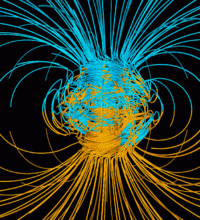
Photo from wikipedia
Magnetoresistive sensors combined with permanent magnets are becoming increasingly popular for measuring mechanical displacement and motion in industrial, automotive, and consumer applications. For measurement of rotation, 360° angle sensors are… Click to show full abstract
Magnetoresistive sensors combined with permanent magnets are becoming increasingly popular for measuring mechanical displacement and motion in industrial, automotive, and consumer applications. For measurement of rotation, 360° angle sensors are often implemented with giant magnetoresistance or tunneling magnetoresistance sensing elements. These magnetoresistive sensors require the use of an antiferromagnet/ferromagnetic pinned layer (PL), and the finite value of the pinning field of these PL structures limits the operating magnetic field range of the sensor due to slight movement of the PL magnetization induced by the component of magnetic field from the rotating permanent magnet that is orthogonal to the PL magnetization direction. This effect shows up as a distortion of the output waveform of the sensor and increased angle measurement error. This limit on magnetic field dynamic range decreases magnet-to-sensor air gap tolerance and makes the sensors more susceptible to error resulting from external magnetic field exposure. In order to solve this problem, a novel magnetic angle sensor design that includes a round ferromagnetic attenuator placed over each magnetoresistive sensing element within the magnetic angle sensor chip was devised. This design has been tested and shown to increase the upper limit of the magnetic field operating range from 200 Oe to over 1 kOe.
Journal Title: IEEE Transactions on Magnetics
Year Published: 2019
Link to full text (if available)
Share on Social Media: Sign Up to like & get
recommendations!